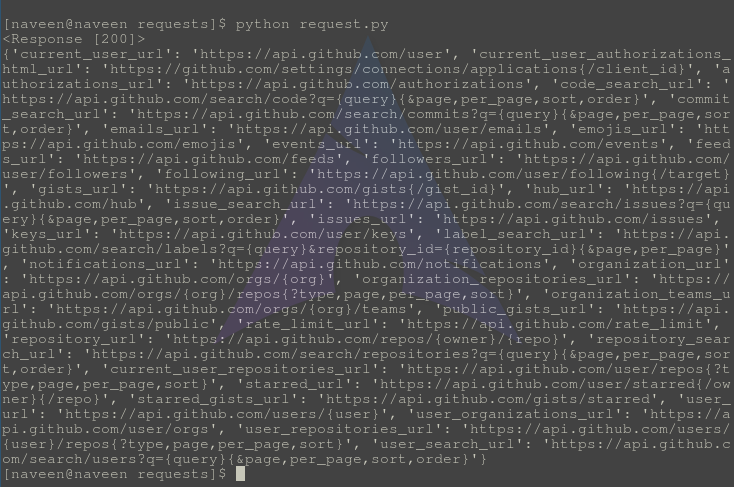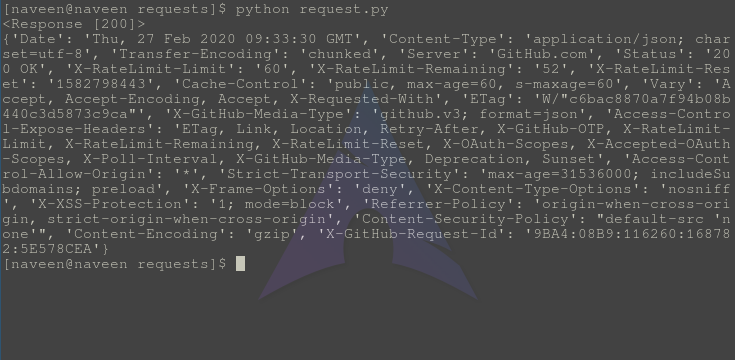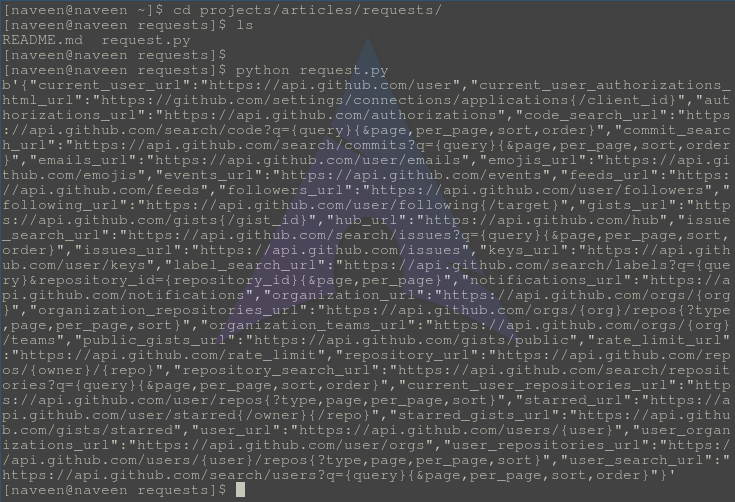Response Methods – Python requests
Last Updated :
23 Jul, 2021
When one makes a request to a URI, it returns a response. This Response object in terms of python is returned by requests.method(), method being – get, post, put, etc. Response is a powerful object with lots of functions and attributes that assist in normalizing data or creating ideal portions of code. For example, response.status_code returns the status code from the headers itself, and one can check if the request was processed successfully or not.
Response object can be used to imply lots of features, methods, and functionalities.
Example :
Python3
import requests
print(response.url)
print(response.status_code)
|
Save this file as request.py, and run using below command
Python request.py

Status code 200 indicates that request was made successfully.
Response Methods
| Method |
Description |
| response.headers |
response.headers returns a dictionary of response headers. |
| response.encoding |
response.encoding returns the encoding used to decode response.content. |
| response.elapsed |
response.elapsed returns a timedelta object with the time elapsed from sending the request to the arrival of the response. |
| response.close() |
response.close() closes the connection to the server. |
| response.content |
response.content returns the content of the response, in bytes. |
| response.cookies |
response.cookies returns a CookieJar object with the cookies sent back from the server. |
| response.history |
response.history returns a list of response objects holding the history of request (url). |
| response.is_permanent_redirect |
response.is_permanent_redirect returns True if the response is the permanent redirected url, otherwise False. |
| response.is_redirect |
response.is_redirect returns True if the response was redirected, otherwise False. |
| response.iter_content() |
response.iter_content() iterates over the response.content. |
| response.json() |
response.json() returns a JSON object of the result (if the result was written in JSON format, if not it raises an error). |
| response.url |
response.url returns the URL of the response. |
| response.text |
response.text returns the content of the response, in unicode. |
| response.status_code |
response.status_code returns a number that indicates the status (200 is OK, 404 is Not Found). |
| response.request |
response.request returns the request object that requested this response. |
| response.reason |
response.reason returns a text corresponding to the status code. |
| response.raise_for_status() |
response.raise_for_status() returns an HTTPError object if an error has occurred during the process. |
| response.ok |
response.ok returns True if status_code is less than 200, otherwise False. |
| response.links |
response.links returns the header links. |
Commonly Used Response Methods
Some methods are most commonly used with response, such as response.json(), response.status_code, response.ok, etc. Requests is mostly used for making http request to APIs(Application Programming Interface). Some of commonly used response methods are discussed here –
response.json()
response.json() returns a JSON object of the result (if the result was written in JSON format, if not it raises an error).
How to use response.json() using Python requests?
To illustrate use of response.json(), let’s ping geeksforgeeks.org. To run this script, you need to have Python and requests installed on your PC.
Example code –
Python3
import requests
print(response)
print(response.json())
|
Example Implementation –
Save above file as request.py and run using
Python request.py
Output –

Check the json content at the terminal output. This basically returns a Python dictionary.
response.ok
response.ok returns True if status_code is less than 200, otherwise False.
How to use response.ok using Python requests?
To illustrate use of response.ok, let’s ping geeksforgeeks.org. To run this script, you need to have Python and requests installed on your PC.
Example code –
Python3
import requests
print(response)
print(response.ok)
|
Example Implementation –
Save above file as request.py and run using
Python request.py
Output –

Check that True which matches the condition of request being less than or equal to 200.
response.status_code
response.status_code returns a number that indicates the status (200 is OK, 404 is Not Found).
How to use response.status_code using Python requests?
To illustrate use of response.status_code, let’s ping api.github.com. To run this script, you need to have Python and requests installed on your PC.
Example code –
Python3
import requests
print(response)
print(response.status_code)
|
Example Implementation –
Save above file as request.py and run using
Python request.py
Output –

Check that and 200 in the output which refer to HttpResponse and Status code respectively.
response.headers
response.headers returns a dictionary of response headers. To check more about headers, visit – Different HTTP Headers
How to use response.headers using Python requests?
To illustrate use of response.headers, let’s ping API of Github. To run this script, you need to have Python and requests installed on your PC.
Example code –
Python3
import requests
print(response)
print(response.headers)
|
Example Implementation –
Save above file as request.py and run using
Python request.py
Output –

response.content
response.content returns the content of the response, in bytes. Basically, it refers to Binary Response content.
How to use response.content using Python requests?
To illustrate use of response.content, let’s ping API of Github. To run this script, you need to have Python and requests installed on your PC.
Example code –
Python3
import requests
print(response.content)
|
Example Implementation –
Save above file as request.py and run using
Python request.py
Output –

Check that b’ at the start of output, it means the reference to a bytes object.
Share your thoughts in the comments
Please Login to comment...